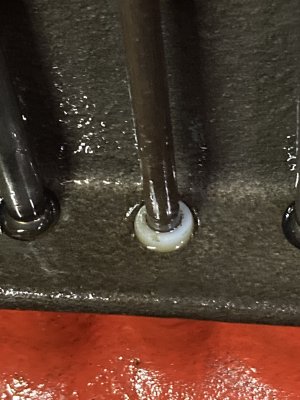remember once I bougght a car that was real junk, it had a burned valve. big chunk missing. not wanting to spend, and just basically fooliung around, i stuck some other valve in there . it had a lot larger stem and head so I turned the valve down on the lathe and made it fit. lapped it in. I knew that was a pokey idea fro mthe get go but was just a kid having fun then, with more time than cash.
not having reamers at hand, I just picked the closest drill bit I had but put new seals ;-) Not the rounded hats but the ones that have springs around the valve stem. I figred maybe that would do it..
no it did not work..
hoo boy the thing ran ok but wow , sure smoked on accelleration and decelleration, It would have this blue smog following it. if I floored it it almost looked like a mist I dont think it could even burn all the oil it used. I drove it a week or two then disassembed the car for parts.
ive seen a few other times where people did a re ring but left the head then had similar issues. I think sometimes a ring job can increase compression and then the problems of the valve stem fit come into the spotlight.
I wonder if there is a solution that doesn't require removing the head? probably not but maybe there is som idea.
I wonder if pressurizing the cyinders might reveal or prove the issue? but then I assume since the valves are closed,during such a test, I guess that realll only really checks the valve seat.
when you said "all new parts", did that include oversize pistons and a rebore or just honing and new rings?
sometimes if there is a top ridge left and if it is only honed, and new rings are installed the compresion ring may hit the ridge and break..
can you be sure it isnt; just getting way too much fuel? is it using a lot of oil?
I recently bought a 30 dollar boroscope, plugs into my phone. it seems to be pretty useful , my suggestion is to try looking inside, maybe that could reveal any scratches in the bore but then maybe it sounds like any practical solution will require head removal anyway.
perhaps possible to have the guides knurled and then reamed, the knurling can reduce the diameter and hold oil. maybe it woudl help and then the valve guides it has might be ok.. a shop that does heads might have an opinion on that or maybe one of the more experienced engine builders here.
I took a head into a engine shop and I had just installed brand new guides so I asked them to ream them. he said that although I had plenty of meat to work with and he could just ream them, that it was preferable to knurl and then ream anyway.. just for the reason of holding oil in the little ridges that the knurling creates..
Maybe then you'd need to just lap the valves in as doing that may move them about ever so slightly?
likely with the "experinece" of needing to take it apart again you may just want to send the head out and have it done for you. I can feel the frustration, knowing it was already a lot of work, time and some money invested. maybe others have alternate suggestions but it sounds like its coming apart again. - as long as it;s not a result of just getting a lot more fuel than it should.
maybe if its fuel youd see more black smoke or maybe smell like its runnign too rich, and with oil maybe more blue smoke and the smell of buring oil. It would be positive if it's fuel related but it might just be a hopeful thought.
maybe do the compression test then do it again wet with a squirt of oil and see if there is any difference in the readings. seeing a big change might suggest the ring sealing is an issue but either would require pulling the head anyway.
Was the ring gap checked ? maybe if it was too small it broke a ring?
maybe a question for others, ,,,
If a ring IS broken would it revel itself at this stage by looking at the bore, for any vertical lines. with the head off? or would you have to pull the pistons to verify that ?

